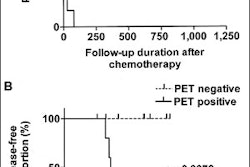German researchers have added painstaking detail to what has become a consensus among virtual colonoscopy providers: that thin collimation and reconstruction intervals produce better images, and improved detection of smaller polyps. Dr. Johannes Wessling, Dr. Roman Fischbach and colleagues from the University of Muenster are not the first group to so conclude, but the sheer breadth of their search for the optimal protocol lends a certain authority to the results.
"While various examination parameters have been suggested by different groups for single-detector row CT colonography, to our knowledge no generally accepted examination protocols have been established for multidetector row (virtual colonoscopy)," they wrote in the current issue of Radiology. "Ideally, the maximum section thickness that allows for the detection of all clinically relevant polyps should be preferred. The minimal spatial resolution required for detection of colorectal lesions, however, needs to be determined" (Radiology, September 2003, Vol. 228:3, pp. 753-759.
Radiation, too, is a concern in population-based screening scenarios, so its influence must be a part of the equation that produces an "optimal" exposure parameter, they added.
The study was performed with the aid of a plastic cylindrical phantom with the approximate attenuation of a bowel wall (45 HU). Nine plastic "sessile polyps" (2, 6, 8, 10, and 12 mm in size) were distributed along the x, y, and z axes. The colon phantom was inserted in a water-filled acrylic cylinder, which then fit inside the polymethyl methacrylate phantom.
Using a four-row CT scanner (Somatom Volume Zoom, Siemens Medical Solutions, Malvern, PA), the group acquired the CT images "using different combinations of detector collimation (4 x 10 mm and 4 x 2.5 mm) dose per section (10, 20, 40, 60, 80, 100 and 140 mAs), tube voltage (120 and 140 kVp), and section thickness/reconstruction interval (1.25/06, 2.0/1.0, 3.0/1.0, and 5.0/3.0 mm). Pitch values were kept constant at 1.5 with 4 x 1.0-mm detector collimation and at 1.0 with 4 x 2.5 mm detector collimation, since the pitch does not influence the section sensitivity profile in our system...."
"To compensate for image noise, we used a very smooth filter (B10) for protocols with a tube current equal to or less than 60 mAs and a medium-smooth filter (B30) for protocols with a tube current greater than 60 mAs," the authors wrote.
Endoluminal views were created for each protocol on a Vitrea 1.1 workstation (Vital Images, Plymouth, MN), using a volume-rendering algorithm with constant rendering parameters. The team assessed polyp visualization and contour depiction on a four-point scale from 0 (not depicted) to 3 (excellent depiction). They graded the longitudinal distortion and degree of rippling artifacts from 0 (severe) to 3 (none), calculating a sum score that accounted for all of the variables. Windose software (Scanditronix Wellhofer, Bartlett, TN) was used to measure effective dose. Image noise was gauged by placing a region of interest in water and calculating the standard deviation from the mean in Hounsfield units.
According to the results, the depiction of polyps 8 mm and larger was rated between 2 (good) and 3 (excellent) for all section thicknesses between 1.25 mm and 5.0 mm, for either 1.25 or 2.5 mm detector collimation, and at all tube currents.
However, longitudinal distortion (resulting in artificially enlarged polyps) and rippling artifacts increased with increasing section thickness and broader detector collimation.
Reconstruction thickness (and to a lesser extent detector collimation) had an important effect on the depiction of polyps 6 mm and smaller. "Depiction of small polyps was superior when 4 x 1.0 mm detector collimation was used for the same reconstructed section thickness (3 mm)," the authors wrote.
When 3-mm section thickness was used, the detector collimation was also important. Endoluminal views based on 3-mm section thickness did not depict 2-mm lesions using 4 x 2.5 mm detector collimation, but the 2-mm lesions were depicted (score 1.0) with 4 x 1.0 mm detector collimation.
Tube current reduction did not influence the depiction of polyps 8 mm and larger when 4 x 1.0 mm detector collimation and 1.25 mm section thickness were used for each protocol, they added, but the effects of tube current reduction were more evident when compared with protocols that used 4 x 1 mm detector collimation and 3-mm section thickness.
"Depiction of smaller polyps deteriorates with reduced tube current, but remains possible, even for low-dose (10 mAs) protocols," the group stated.
Image noise increased with the use of thin-section collimation (1.25 - 2.0 mm) and reduced tube current. "The image noise of the 4 x 1.0 mm collimation was 24.8 HU at 80 mAs, compared with 17.8 HU at 140 mAs," the authors wrote. Use of a smooth filter reduced noise to 19.3 HU at 60 mAs, less than with a normal filter at 80 mAs (24.8 HU).
In terms of sum score of all protocols, the protocols that relied on 4 x 1.0-mm detector collimation were superior to those using 2.5-mm collimation.
"Low-dose thin-section protocols tended to be superior to high-dose protocols with 4 x 2.5 mm detector collimation, and were only slightly different from high-dose thin-section protocols," they wrote.
The authors concluded that 4 x 1.0-mm detector collimation, 1.25-mm section thickness, pitch 1.5 and as a prerequisite for low-dose (10 mAs) virtual colonoscopy. "Depiction of small polyps with this protocol is superior to depiction with normal-dose protocols, which use a wider detector collimation with a section thickness of 3 mm," Wessling and colleages wrote.
However, they cautioned that the use of a phantom, a facsimile without patient movement or residual fecal material, made finding polyps easier than it would have been in human subjects.
The authors recommended the use of low-dose protocols as the quickest and most cost-effective way to examine a screening population. However, low-dose imaging significantly reduces the ability to detect extracolonic abnormalities, and therefore may not be the best choice in high-risk patients, they stated.
"For patients in whom colorectal carcinoma is known or highly suspected to exist, the search for extracolonic abnormalities is justified," the authors wrote. "....it might be reasonable to examine at-risk patients with a normal-dose thin-section contrast material-enhanced protocol (in prone position) first, followed by a low-dose thin-section protocol with the patient in the supine position. This procedure might help reduce the radiation dose substantially, even in symptomatic patients."
By Eric BarnesAuntMinnie.com staff writer
September 25, 2003
Related Reading
Virtual colonoscopy techniques evolve with technology, July 25, 2003
Thin slices, narrow collimation rule in virtual colonoscopy study, March 8, 2003
Copyright © 2003 AuntMinnie.com




















